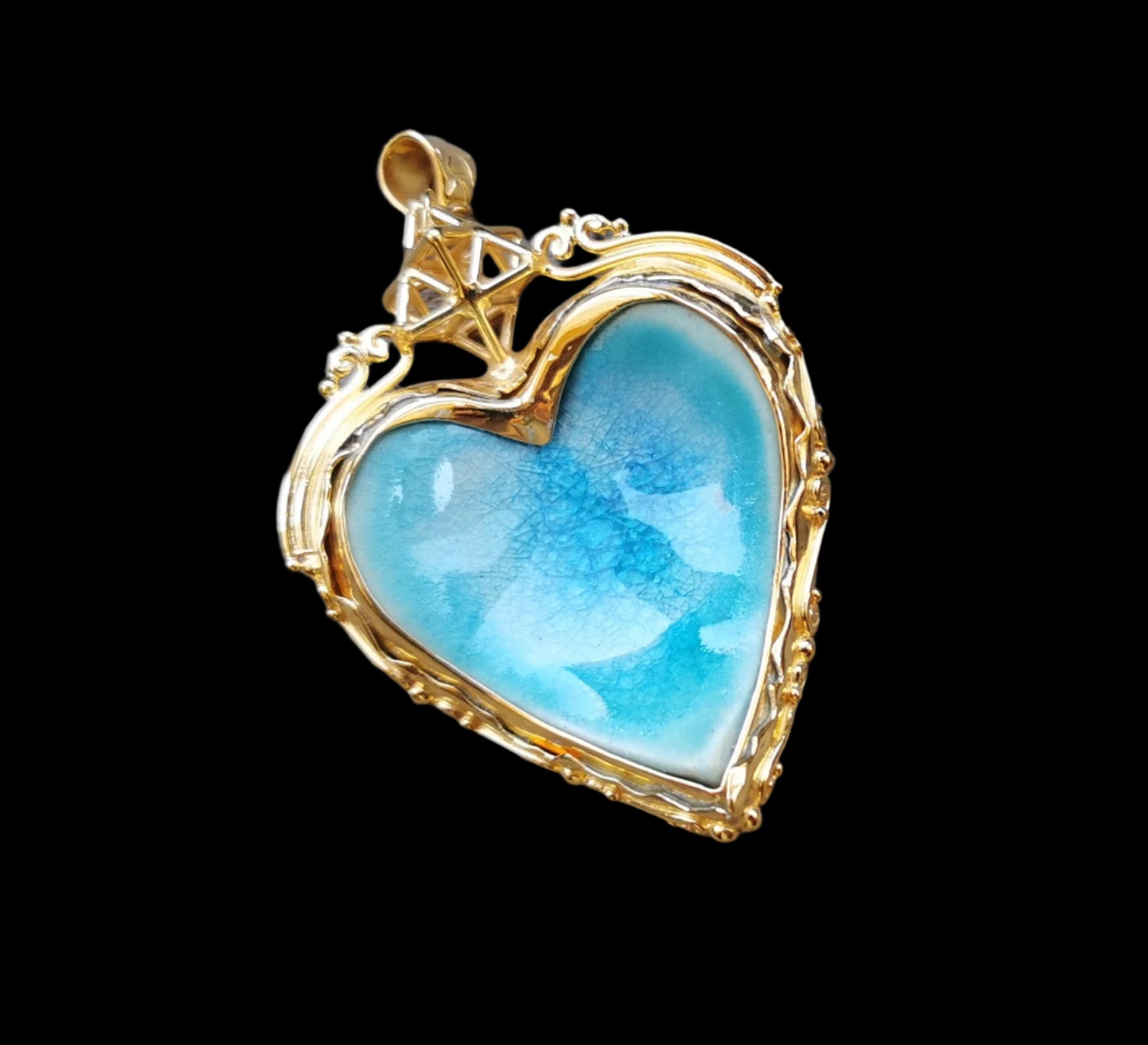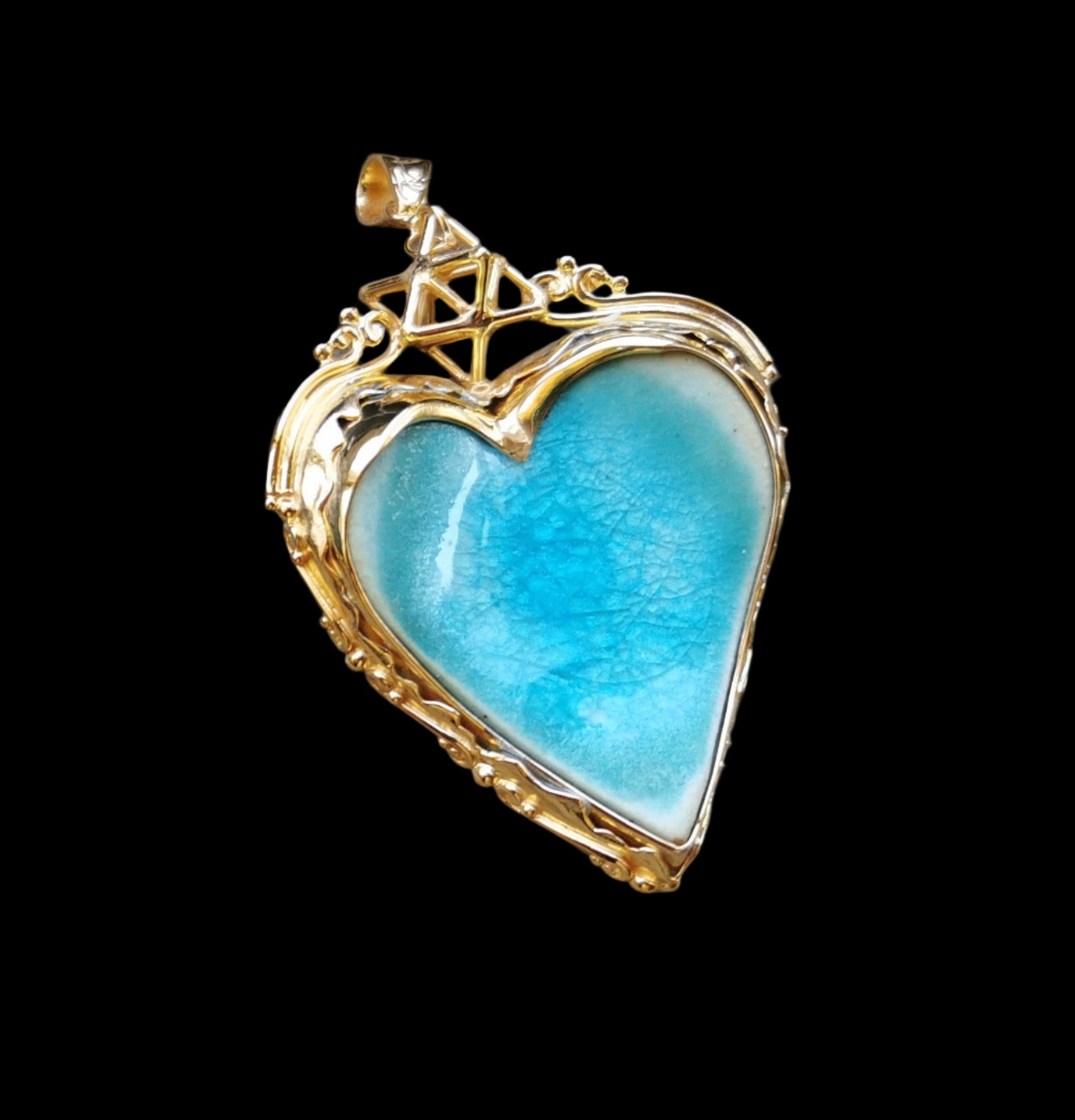Portal Glastonbury
Ref.PD0282
Ref.PD0282
Couldn't load pickup availability
Ref.PD0282 - Gold plated on silver pendant with Tantric Star geometry, and ceramic blue heart.
The heart, a universal symbol recognized across cultures, carries profound symbolic significance rooted in its biological role as the organ of life and its metaphorical associations with emotion, connection, and essence. Its meaning centers on love, vitality, courage, and inner truth, reflecting fundamental human experiences and natural rhythms.
Symbolic Significance
At its core, the heart symbolizes love and emotional connection. Its association with affection—romantic, familial, or platonic—stems from its role in sustaining life, pulsing with blood that nourishes the body. The heart shape, stylized as two curved lobes meeting at a point, evokes intimacy and unity, representing bonds that give life meaning, such as partnerships, friendships, or self-love. It suggests that love is both a vital force and a choice to nurture relationships.
Vitality and life force are key themes. The heart’s ceaseless beat mirrors the rhythm of existence, symbolizing energy, passion, and the drive to live fully. Its centrality in the body makes it an emblem of the core self, the seat of one’s truest desires and motivations, encouraging authenticity and alignment with personal values.
Courage and strength also define the heart. Phrases like “take heart” or “heart of a lion” reflect its symbolic link to bravery and resilience, representing the inner fortitude needed to face challenges or stand for beliefs. This ties to emotional courage, such as vulnerability in expressing feelings or perseverance through hardship, highlighting the heart’s dual role as both tender and tough.
The heart symbolizes inner truth and intuition. Often described as the “voice of the heart,” it represents instinctive wisdom, urging trust in feelings over logic alone. This makes it an emblem of self-awareness, guiding decisions that resonate with one’s deepest sense of purpose or integrity.
Balance and duality are inherent in its symbolism. The heart’s two sides—left and right chambers, or the stylized lobes—suggest harmony between opposites, like emotion and reason, giving and receiving. This balance reflects the need to integrate passion with stability, fostering healthy relationships and personal growth.
Spiritual and Philosophical Significance
Spiritually, the heart is a focal point for inner exploration. Its steady rhythm invites meditation on life’s continuity, symbolizing a connection to the pulse of existence—personal and collective. Contemplating the heart can foster self-compassion, encouraging alignment of actions with core values and a sense of unity with others through shared humanity.
Philosophically, the heart challenges purely rational perspectives. Its link to emotion and intuition suggests that truth encompasses both head and heart, promoting a holistic understanding of life. The heart symbolizes the courage to embrace vulnerability as a strength, urging authenticity in a world often driven by external measures.
Its universality allows personal interpretations. The heart might represent romantic devotion, empathy for others, or the pursuit of passion, making it a versatile symbol for individual or collective aspirations.
Cultural Contexts
Ancient Traditions: In ancient Egypt, the heart was weighed against a feather to judge one’s moral worth, symbolizing truth and integrity. In Chinese philosophy, the heart (xin) governs mind and emotion, reflecting wisdom and balance.
Western Culture: The heart shape, popularized in medieval Europe, became a romantic icon by the Renaissance, seen in art and valentines, symbolizing love and devotion.
Modern Contexts: Hearts dominate emojis, logos, and art, symbolizing affection, compassion, or vitality, as in campaigns like heart health awareness. Tattoos often feature hearts to mark personal bonds or resilience.
Global Symbolism: Across cultures, hearts appear in folklore, poetry, and rituals, symbolizing the essence of humanity, from Japan’s “kokoro” (heart-mind) to African proverbs about heartfelt wisdom.
The heart’s symbolic significance weaves together love, vitality, courage, and inner truth. It embodies the life-giving pulse of connection, the bravery to live authentically, and the wisdom of intuition, inviting reflection on personal bonds, resilience, and one’s place in the rhythm of existence.
Tantric Star
Activation: Initiation, Inspiration
The Tantric Star is formed by interlocking ascending and descending tetrahedrons (see Tetrahedron). Also known as the Mer Ka Ba, the Tantric Star functions as a 3-dimensional mandala, connecting us to our centre point, a stargate into the matrix of manifest reality. It describes the energy pattern created by the electromagnetic male and female potencies of creation as they come together to conceive atoms, Humans, the Universe - the seminal form that Consciousness takes as it initiates the polarisation of the Monad into the sacred enclosure of the Trinity, holding the frequency of the 3rd dimension fully manifest in form.
This form protects against unbalanced magnetic emanations, eg, mobile and cordless phones.
Size: 74mm/2.91in approx.




